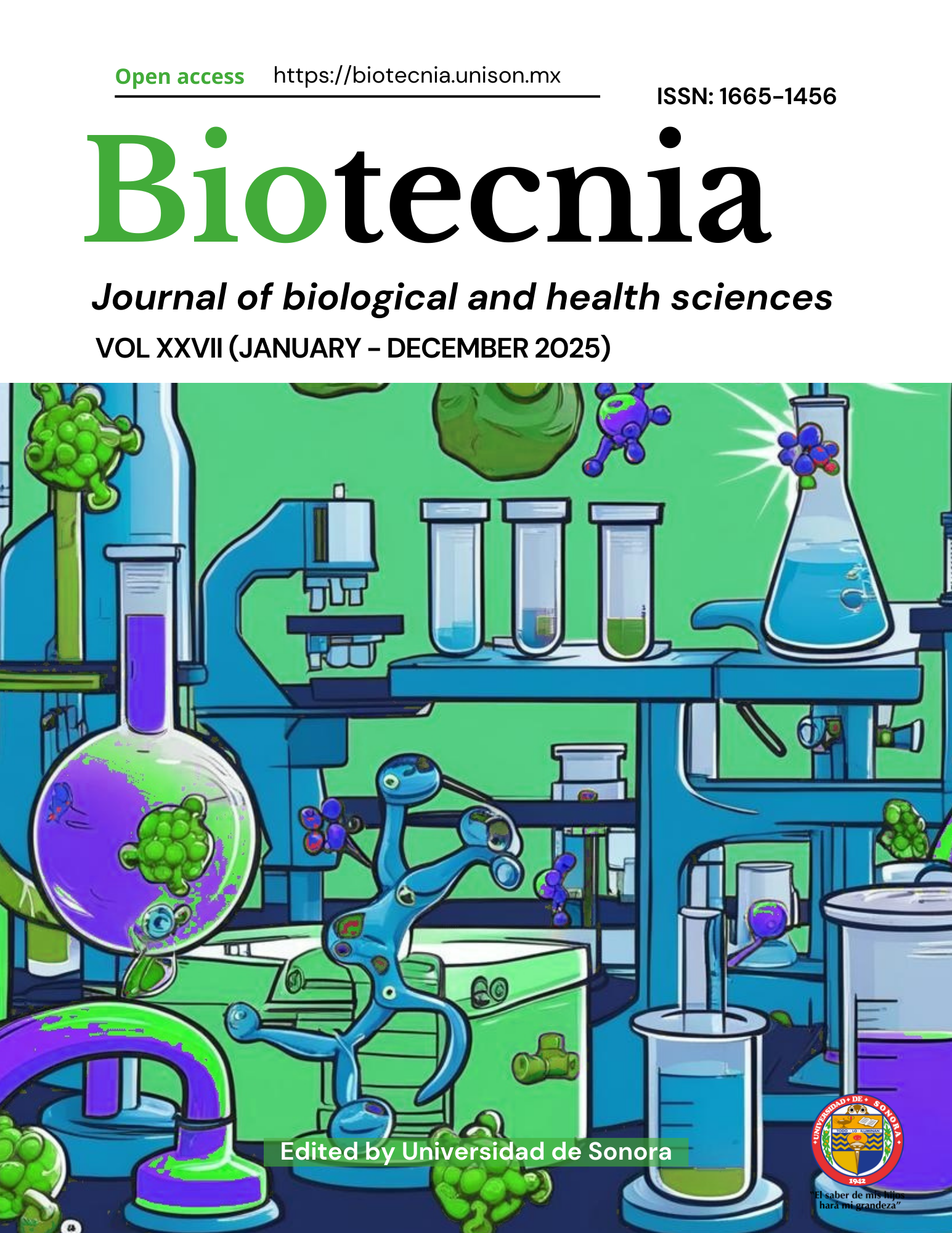Degradación simultánea de compuestos fenólicos bajo condiciones desnitrificantes en un reactor UASB provisto con carbón activado granular
DOI:
https://doi.org/10.18633/biotecnia.v27.2452Palabras clave:
Compuestos fenólicos, carbón activado, isotermas de adsorción, reactor UASBResumen
El presente trabajo, estudió la capacidad de eliminación de una mezcla de compuestos fenólicos (phenol, p-cresol, o-cresol) por vía desnitrificante; además, el efecto del carbón activado granular (CAG) en el proceso realizado en reactores UASB (up-flow anaerobic sludge blanket). La carga orgánica se fue incrementando de 450 a 3250 mg C L-1d-1, mediante el ajuste del TRH de 2 to 0.25 d en el reactor con CAG y en el reactor control sin CAG. Las eficiencias de eliminación de los compuestos fenólicos aumentaron a medida que se incrementó la carga orgánica, obteniéndose valores del 89.7 % al 95.5 % en el reactor sin CAG, y del 95.8 al 99.1 % en el reactor con CAG. Para la eliminación de nitrato, el reactor con CAG alcanzó eficiencias de 79.3 % a 98.0 %, mientras que el control obtuvo 64.8 % a 96.9 %. Finalmente, se evaluaron las capacidades máximas del CAG mediante isotermas de ad[1]sorción, obteniéndose los siguientes valores (mg g-1): 164.6 para o-cresol, 134.5 para p-cresol, 110.7 para fenol y 44.4 para nitrato. Los resultados muestran la capacidad de un proceso desnitrificante de eliminar simultáneamente una mezcla de compuestos fenólicos, además, se observó que el CAG incrementó la eficiencia eliminación de todos los compuestos.
Descargas
Citas
Ahalya, N., Kanamadi, R. D., & Ramachandra, T. V. (2006) Biosorption of iron (III) from aqueous solutions using the husk of Cicer arientinum. Indian Journal of Chemical Technology 13: 122-127. http://nopr.niscpr.res.in/handle/123456789/7010
Annadurai, G., Juang, R. S., & Lee, D. J. (2002). Biodegradation and adsorption of phenol using activated carbon immobilized with Pseudomonas putida. Journal of Environmental Science and Health, Part A, 37(6), 1133-1146.
Al-Degs Y, Khraisheh MAM, Allen SJ, Ahmad MN (2000) Effect of carbon chemistry on the removal of reactived dyes from textile effluent. Water Res 34(3): 927-935
APHA (1985) Standard methods for examination of water and wastewater. American Public Health Association, Washington, D. C.
Beristain-Cardoso, R., Texier, A. C., Sierra-Álvarez, R., Razo-Flores, E., Field, J. A., & Gomez, J. (2009). Effect of initial sulfide concentration on sulfide and phenol oxidation under denitrifying conditions. Chemosphere, 74(2), 200-205. https://doi.org/10.1016/j.chemosphere.2008.09.066
Blanco-Martínez DA, Giraldo L, Moreno-Piraján JC (2009) Effect of the pH in the adsorption and in the immersion enthalpy of monohydroxylated phenols from aqueous solutions on activated carbons. J Hazard Mater 169:291-296
Cervantes FJ, Meza-Escalante ER, Texier AC, Gómez J (2009) Kinetic limitations during the simultaneous removal of p-cresol and sulfide in a denitrifying process. Journal of Industrial Microbiology and Biotechnology 36(11), 1417.https://doi.org/10.1007/s10295-009-0628-6
Dąbrowsky A, Podkościelny P, Hubicki Z, Barczak M (2005) Adsorption of phenolic compounds by activated carbon—a critical review. Chemosphere 58:1049-1070
Feng L, Han Y, Niu J, Guo J, Zhang J, Li H, Hou Y, Song Y (2023) Synergistic removal performance and mechanism in denitrification system under phenol stress, Journal of Environmental Chemical Engineering 11 (5): 110767. https://doi.org/10.1016/j.jece.2023.110767
Fu, L., Li, J., Wang, G., Luan, Y., & Dai, W. (2021). Adsorption behavior of organic pollutants on microplastics. Ecotoxicology and Environmental Safety, 217, 112207. https://doi.org/10.1016/j.ecoenv.2021.112207
Ge, C. H., Sun, N., Kang, Q., Ren, L. F., Ahmad, H. A., Ni, S. Q., & Wang, Z. (2018). Bacterial community evolutions driven by organic matter and powder activated carbon in simultaneous anammox and denitrification (SAD) process. Bioresource Technology, 251, 13-21.
González-Blanco, G., Beristain-Cardoso, R., Cuervo-López, F., Cervantes, F. J., & Gómez, J. (2012). Simultaneous oxidation of ammonium and p-cresol linked to nitrite reduction by denitrifying sludge. Bioresource Technology, 103(1), 48-55. https://doi.org/10.1016/j.biortech.2011.09.086
González‐Blanco G, Cuervo‐López F, Cervantes FJ, Beristain‐Cardoso R, Gómez J (2013). Nitrite as oxidizing power for p‐cresol removal using a denitrifying sludge: kinetic study. Journal of Chemical Technology & Biotechnology, 88(12), 2176-2180. https://doi.org/10.1002/jctb.4082
Hamdaoui O, Naffrechoux E (2007) Modeling of adsorption isotherms of phenol and chlorophenols onto granular activated carbon Part I. Two-parameter models and equations allowing determination of thermodynamic parameters. J Hazard Mater 147:381-394
Juang, R. S., Wu, F. C., & Tseng, R. L. (1996). Adsorption isotherms of phenolic compounds from aqueous solutions onto activated carbon fibers. Journal of Chemical & Engineering Data, 41(3), 487-492. https://doi.org/10.1021/je950238g
Jung MW, Ahn KH, Lee Y, Kim KP, Rhee JS, Park JT, Paeng KJ (2001) Adsorption characteristics of phenol and chlorophenols on granular activated carbons (GAC). Microchem J, 70(2):123-131
Li, M., Xiao, J., Zeng, Z., Zhang, T., & Ren, Y. (2023). Study on the biodegradation of phenol by Alcaligenes faecalis JH1 immobilized in rice husk biochar. Frontiers in Environmental Science, 11, 1294791.
Li, H., Wang, F., Li, J., Deng, S., & Zhang, S. (2021). Adsorption of three pesticides on polyethylene microplastics in aqueous solutions: Kinetics, isotherms, thermodynamics, and molecular dynamics simulation. Chemosphere, 264, 128556. https://doi.org/10.1016/j.chemosphere.2020.128556
Lin SH, Juang RS (2009) Adsorption of phenol and its derivates from water using synthetic resins and low-cost natural adsorbents: A review. J of Environ Manage, 90:1336-1349
Liu C., Han K., Lee DJ, Wang O (2016) Simultaneous biological removal of phenol, sulfide, and nitrate using expanded granular sludge bed reactor, Appl Microbiol Biotechnol 100, 4211–4217 https://doi.org/10.1007/s00253-016-7293-2
Liu L, Tan SJ, Horikawa T, Do DD, Nicholson D, Liu J (2017). Water adsorption on carbon-A review. Advances in colloid and interface science, 250: 64-78. https://doi.org/10.1016/j.cis.2017.10.002.
Mahdavianpour M, Moussavi G, Farrokhi M (2018). Biodegradation and COD removal of p -Cresol in a denitrification baffled reactor: Performance evaluation and microbial community. Process Biochemistry, 69, 153–160. doi:10.1016/j.procbio.2018.03.01
Martínez S, Cuervo-López FM, Gomez J (2007) Toluene mineralization by denitrification in an up flow anaerobic sludge blanket (UASB) reactor, Bioresource Technology, 98(9) 1717-1723 https://doi.org/10.1016/j.biortech.2006.07.046
Meza-Escalante ER, Texier AC, Cuervo-López F, Gómez J, Cervantes FJ (2008) Inhibition of sulphide on the simultaneous removal of nitrate and p-cresol by denitrifying sludge. J Chem Technol Biotechnol 83:372-377
Monroy, M. (2010). Carbones activados con actividad biológica: Aplicación en la degradación de compuestos fenólicos procedentes de aguas residuales de la industria metalúrgica de Nobsa-Boyacá Manuel. Universidad Nacional de Colombia Facultad de Ciencias Posgrado Ciencias-Microbiología, 89. https://repositorio.unal.edu.co/handle/unal/11280
Moreno C, Rivera-Utrilla J, López-Ramón MV, Carrasco-Marín F (1995) Adsorption of some substituted phenols on activated carbons from a bituminous coal. Carbon 33(6): 845-851
Nouri S, Haghseresht F, Max Lu GQ (2002a) Comparison of adsorption capacity of p-cresol and p-nitrophenol by activated carbon in single and double solute. Adsorption 8(3):215-223. doi:10.1023/a:1021260501001
Nouri, S., Haghseresht, F., & Lu, M. (2002b). Adsorption of aromatic compounds by activated carbon: effects of functional groups and molecular size. Adsorption Science & Technology, 20(1), 1-15.
Peña-Calva A, Olmos-Dichara A, Viniegra-González G, Cuervo-López FM, Gómez J (2004) Denitrification in presence of benzene, toluene and m-xilene: kinetics, mass balance and yields. Appl Biochem Biotechnol 119: 195-208
Reyes-Avila J, Razo-Flores E, Gómez J (2004) Simultaneous removal of nitrogen, carbon and sulfur by denitrification. Water Res 38:3313-3321
Ribeiro R, de Nardi IR, Fernandes BS, Foresti E, Zaiat M (2013) BTEX removal in a horizontal-flow anaerobic immobilized biomass reactor under denitrifying conditions. Biodegradation 24, 269–278. https://doi.org/10.1007/s10532-012-9585-2
Riser-Roberts, E. 1992. Bioremediation of Petroleum contamined sites. CRC press. United States Of America. review. Enzyme Microbial. Technology. 14: 170-183.
Sierra-Alvarez R, Guerrero F, Rowlete P, Freeman S, Field JA (2005) Comparison of chemo-, hetero- and mixotrophic denitrification in laboratory-scale UASBs. Water Sci Technol 52:337-342.
Singh, N., Agarwal, B., & Balomajumder, C. (2016). Simultaneous treatment of phenol and cyanide containing aqueous solution by adsorption, biotreatment and simultaneous adsorption and biotreatment (SAB) process. Journal of Environmental Chemical Engineering, 4(1), 564–575. doi:10.1016/j.jece.2015.11.041
Descargas
Publicado
Cómo citar
Número
Sección
Licencia
Derechos de autor 2025

Esta obra está bajo una licencia internacional Creative Commons Atribución-NoComercial-CompartirIgual 4.0.
La revista Biotecnia se encuentra bajo la licencia Atribución-NoComercial-CompartirIgual 4.0 Internacional (CC BY-NC-SA 4.0)
















_(2).jpg)








